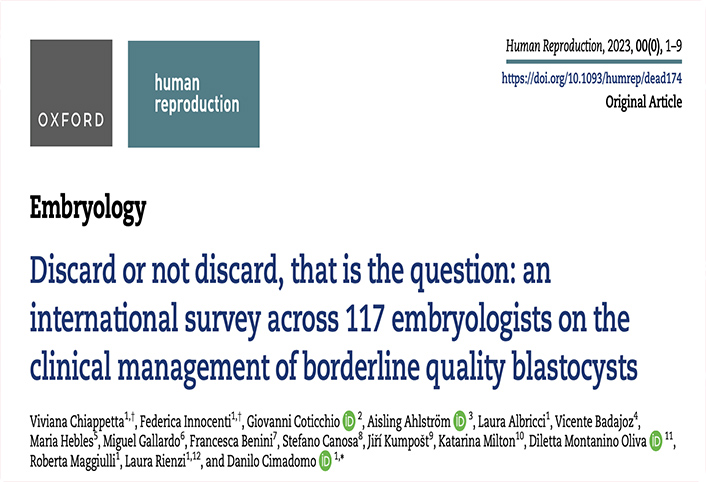
Viviana Chiappetta, Federica Innocenti, Giovanni Coticchio, Aisling Ahlstro, Laura Albricci, Vicente Badajoz,
Maria Hebles, Miguel Gallardo, Francesca Benini, Stefano Canosa, Jirí Kumpošt, Katarina Milton, Diletta Montanino Oliva, Roberta Maggiulli, Laura Rienzi, and Danilo Cimadomo.
Abstract
STUDY QUESTION: Do embryologists from different European countries agree on embryo disposition decisions (‘use’ or ‘discard’) about Day 7 (>144 h post-insemination) and/or low-quality blastocysts (LQB; <Gardner’s BB) (i.e. borderline quality blastocysts)?
SUMMARY ANSWER: The prevalence of ‘discard’ answers was 38.7%; nevertheless, embryologists’ agreement was overall just fair (Fleiss-k 1⁄4 0.26).
WHAT IS KNOWN ALREADY: The utilization of LQBs and adoption of culture beyond 144h post-insemination is increasing worldwide. Although morphology and morphokinetics are associated with embryo developmental competence, previous studies demonstrated significant interobserver variability among embryologists regarding embryo quality assessment and disposition decisions for borderline quality blastocysts.
STUDY DESIGN, SIZE, DURATION: An anonymous survey was run in a large network of IVF centers. A total of 117 embryologists from 6 European countries and 29 IVF centers filled in the survey. Randomly selected anonymous time-lapse videos of 50 Day 7 and/or LQB whole embryo preimplantation development were assessed by the embryologists. The key information on patients/cycles was provided along with each video. All cycles entailed preimplantation genetic testing for aneuploidies. Each embryologist specified whether he/she would have discarded or used (‘transfer-fresh’/‘cryopreserve’/‘biopsy’) any embryo. Inter-rater agreement was mea- sured with Fleiss-k.
PARTICIPANTS/MATERIALS, SETTING, METHODS: Examiners were asked about their years of experience, center location, average number of cycles and average maternal age, number of colleagues, and use of time-lapse incubators at their centers. All participants were blinded to artificial intelligence (AI) scores generated by two commercially available software packages, chromosomal diagnosis (all blastocysts were tested for aneuploidies), and clinical outcomes after vitrified-warmed euploid single blastocyst transfer. These data were known only by one embryologist not involved in the survey.
MAIN RESULTS AND THE ROLE OF CHANCE: Participants were Italian (40%, N1⁄447), Spanish (24%, N1⁄428), Portuguese (5%, N1⁄46), Czech (5%, N 1⁄4 6), Swedish (23%, N 1⁄4 27), and Icelandic (3%, N 1⁄4 3). In total, 2263 (38.7%) ‘discard’ and 3587 (61.3%) ‘use’ decisions were recorded. Czech, Portuguese, and Italian embryologists expressed lower ‘discard’ decision rates (mean § SD 17 § 7%, range 8–24%; 23 § 14% range 4–46%; and 27 § 18% range 2–72%, respectively), while Spanish gave intermediate (37 § 16% range 4–66%) and Nordic gave higher (67 § 11% range 40–90%) rates. The prevalence of ‘discard’ answers was 38.7% out of 5850 choices (mean per embryologist: 39 § 23% range 2–90%). Only embryologists’ country and IVF group were associated with this rate. Overall agreement among embryol- ogists was fair (Fleiss-k1⁄40.26). The prevalence of ‘discard’ responses per embryo was 37§24% (range 2–87%). Only the number of sibling blastocysts influenced this rate (i.e. the larger the cohort, the higher the inclination to ‘discard’). No difference was shown for the two scores between euploid and aneuploid borderline quality blastocysts, while the embryologists were, by chance, more prone to ‘discard’ the latter (28.3 § 21% range 9–71% versus 41.6 § 24.8% range 2–87%, respectively).
LIMITATIONS, REASONS FOR CAUTION: The survey included only private IVF clinics located in Europe. Moreover, a key variable is missing, namely patients’ access to care. Indeed, all embryologists involved in the survey were part of the same network of private IVF clinics, while the embryo disposition decisions might be different in a public setting.
WIDER IMPLICATIONS OF THE FINDINGS: Decision-making by European embryologists regarding Day 7 embryos or LQBs is inconsistent with putative clinical consequences, especially in patients with low prognosis. Although the embryologists could make decisions independent from their local regulations, their mindset and clinical background influenced their choices. In the future, AI tools should be trained to assess borderline quality embryos and empowered with cost-effectiveness information to support embryologists’ decisions with more objective assessments.
STUDY FUNDING/COMPETING INTEREST(S): No external funding was obtained for this study. The authors have no conflict of interest to declare.
TRIAL REGISTRATION NUMBER: N/A.